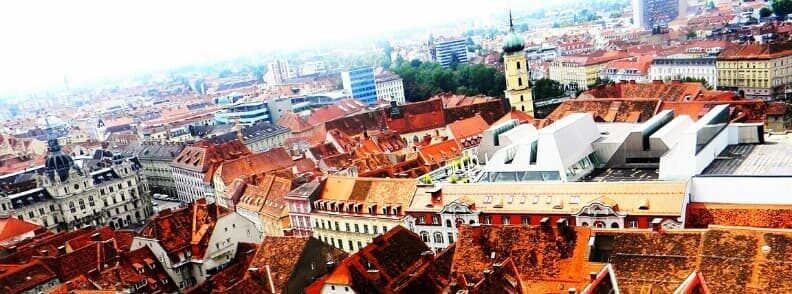Graz is one of those cities that never ceases to amaze me, no matter how many times I visit. Nestled in the heart of Styria, it’s Austria’s second-largest city, but to me, it feels like a well-kept secret. I’ve lived in the region for years, and every time I come back to visit Graz, I discover something new — something that pulls me deeper into its rich cultural tapestry.
For tourists who visit Graz for the first time, this city offers a perfect blend of history, vibrant urban life, and modern attractions. And the best part? You can experience its highlights in just one day.
My first trip to Graz was on a family holiday as a child. I still remember the moment I climbed up to Schlossberg with my parents, gazing down at the red rooftops of the old town, feeling like I had stepped into another world. The iconic Uhrturm clock tower stood tall against the sky, silently watching over the city, as it has for centuries. That view is something I always recommend to any Graz tourist — there’s nothing quite like it.
Over the years, as I’ve revisited Graz, I’ve realized that what makes this city so special is its perfect balance. Graz has an undeniable sense of history, with its baroque palaces, medieval armory (the famous Landeszeughaus), and the grand Erzherzog Johann Brunnen, which greets you in the main square, the Hauptplatz. But it’s not just about the past — there’s a fresh, modern pulse here too. The striking Kunsthaus, with its futuristic design, and the quirky Murinsel, a floating platform on the Mur River, are just two examples of how Graz blends the old with the new.
For anyone planning to visit Graz, my advice is simple: give yourself at least one full day. While the city can certainly be explored in that time, don’t be surprised if you find yourself wanting to stay longer. From strolling through the narrow, cobblestone streets to enjoying a meal at one of the cozy, traditional Styrian restaurants, Graz has a way of pulling you in. And even if you’re here just for a day, you’ll leave with a sense that you’ve truly experienced the soul of the city—whether you’re fascinated by its history or drawn to its contemporary art and culture.
So, whether you’re here for a short trip or planning a longer stay, Graz is a city that will leave you wanting more. You may arrive as a tourist, but you’ll leave with memories that feel like you’ve uncovered a hidden gem in Austria. Trust me, as someone who’s been visiting Graz for years, this city is a place you’ll keep coming back to.
Disclosure: Some of the links below are affiliate links. This means that at no extra cost to you, The Travel Bunny will earn a small commission if you click through and make a purchase. Thank you!
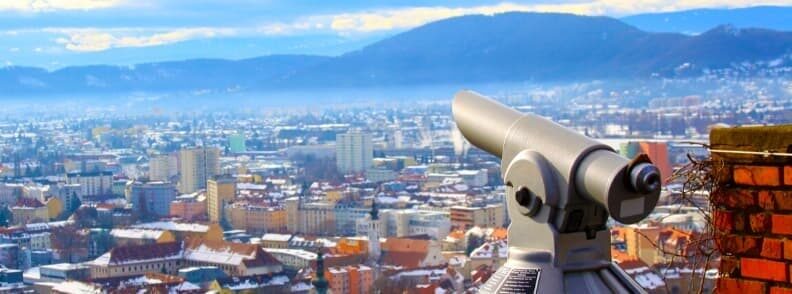
What to see in Graz in one day
When visiting Graz for the first time, it’s easy to feel overwhelmed by the sheer number of sights and experiences this charming city has to offer. As someone who has wandered its streets countless times, let me take you through the perfect day in Graz, balancing the city’s historical treasures with modern highlights. With just one day, you can explore the very best of what Graz has to offer — starting with breathtaking views and ending with some of the city’s most cutting-edge attractions. Here’s my personal go-to plan for a day that captures the spirit of Graz.
Start at the Mariatrost Basilica
Before diving into the heart of the city, I suggest beginning your day at the Mariatrost Basilica, located on the outskirts of Graz. This stunning baroque church sits atop a hill and is one of the most important pilgrimage sites in Austria. The first time I visited, I was awestruck by the grandeur of its twin towers and the peaceful, contemplative atmosphere inside. Whether you’re religious or not, the view from the basilica alone makes the trip worthwhile. Plus, starting your day here gives you a sense of Graz’s connection to its wider region.
After exploring the basilica, drive back towards the city center and park near the Graz Opera House, a beautiful neo-baroque building that’s hard to miss. Just a heads-up — parking in downtown Graz can be tricky, but the underground lots near the Opera House are convenient and central.
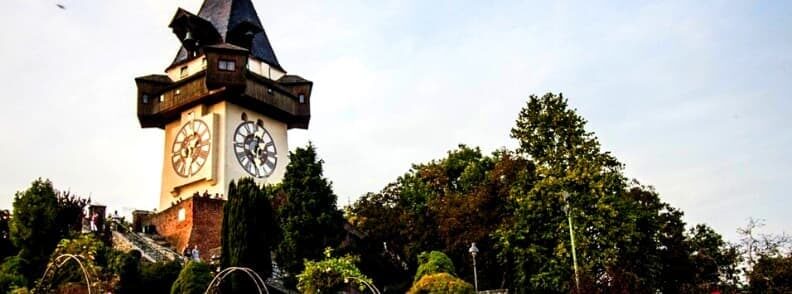
A Walk Through Historic Graz
Once you’ve parked, it’s time to head straight for one of Graz’s most iconic landmarks: Schlossberg. Climb the steps or take the funicular to the top of this hill to see the Uhrturm (Clock Tower), a symbol of the city. The view from here is unforgettable — looking out over the red rooftops of the old town with the clock tower standing proudly in the foreground. I never get tired of that panorama, and I always recommend starting your visit to Graz here to really get a sense of the city’s layout and charm.
From Schlossberg, make your way down to the Hauptplatz (main square), where the Erzherzog Johann Brunnen (Archduke Johann Fountain) is a perfect place to pause and soak in the city’s lively atmosphere. You’ll find this bustling square full of locals and tourists, making it the ideal spot for a break. Grab a quick snack from a nearby stall, or sit at a café and watch as Graz goes about its day.
As you explore the surrounding streets, don’t miss Herrengasse, the city’s famous shopping street lined with boutiques and cafes. Along the way, you’ll pass Landeszeughaus (the Armory), which houses one of the largest collections of medieval weapons and armor in the world. If you’re a history buff — or even if you’re not — this museum is a must-see. The sight of thousands of weapons lined up is both impressive and slightly overwhelming, giving you a glimpse into Graz’s military past.
Just next door is Landhaus, a Renaissance palace that serves as the headquarters of the Styrian Provincial Government. The arcaded courtyard here is one of the most beautiful examples of Renaissance architecture in Austria, and it’s a peaceful spot to take a few photos before heading to lunch.
Time for Lunch at Landhauskeller
For lunch, I always recommend Landhauskeller, located right next to the Landhaus. This restaurant is a favorite among locals, offering a cozy atmosphere and traditional Styrian cuisine. Try the Backhendl (crispy fried chicken) or a platter of Brettljause, a spread of cured meats, cheeses, and freshly baked bread. Paired with a glass of local wine, it’s the perfect way to refuel before continuing your exploration of Graz.
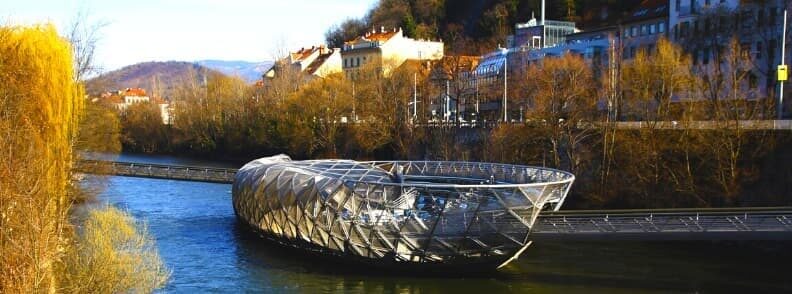
Dive Into Modern Graz at Kunsthaus and Murinsel
After lunch, it’s time to explore the modern side of Graz. Walk towards the Mur River, where you’ll find two of the city’s most unique attractions: Kunsthaus Graz and Murinsel. The Kunsthaus, also known as the Friendly Alien, is an architectural wonder that houses contemporary art exhibits. Its futuristic design stands in stark contrast to the historical buildings you’ve been seeing all day, but that’s what makes Graz so special — this seamless blend of old and new.
Just a short walk from the Kunsthaus is Murinsel, a floating platform on the Mur River designed by New York artist Vito Acconci. Part amphitheater, part café, and part children’s playground, this island offers a perfect place to rest and enjoy the river views. It’s quirky and modern, but it’s also a reminder of Graz’s forward-thinking spirit.
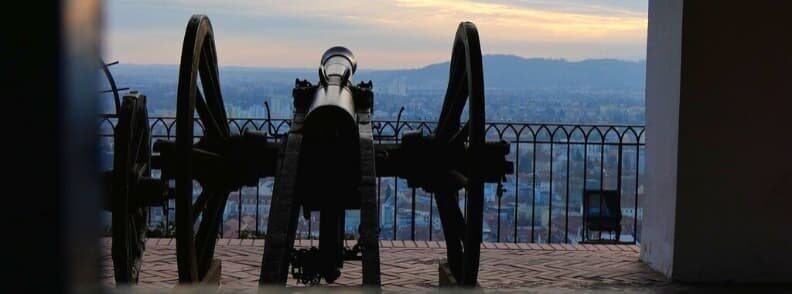
Return to the Schlossberg
End your day by heading back to Schlossberg for one last look at the city as the sun begins to set. This time, explore some of the lesser-known spots on the hill, like the Stallbastei (Stable Bastion) with its old cannons, or the Glockenturm (Bell Tower), which dates back to 1588. As you wander back down, take the time to pause at the Schlossbergstollen (Schlossberg Tunnel), a fascinating network of tunnels built into the mountain and once used as air-raid shelters during WWII.
By the end of your day, you’ll have experienced the very best of Graz — from its historical landmarks to its modern marvels, with a taste of local culture in between. Whether you’re sipping wine on the Murinsel or standing in awe of the Landeszeughaus’s armory collection, this city has a way of capturing your heart. Graz may be small, but it packs an unforgettable punch in just one day.
Graz’s Rich Cultural Experiences
When I think of what makes Graz special, it’s the deep connection between its past and present that stands out. Every corner of this city tells a story, and there are a few spots that I love to return to, time and time again. Whether it’s immersing myself in history at the Landeszeughaus or enjoying a cozy meal at Landhauskeller, these experiences are what give Graz its charm. Let me share with you some of my favorite cultural highlights that I always recommend to anyone visiting for the first time.
Landeszeughaus: A Local Favorite for History Buffs
Every time I visit Graz, I make a point of stopping by the Landeszeughaus. For anyone who loves history, it’s an absolute treasure trove. Housed in an unassuming building in the city’s historic center, the Landeszeughaus contains the world’s largest collection of medieval armor. It’s like stepping back in time to when Graz was on the front lines of defending Europe from Ottoman invasions. The rows upon rows of helmets, breastplates, and swords are both fascinating and a little overwhelming.
I’ve visited multiple times, and yet I always find something new that catches my eye. On one trip, it might be the intricacy of a particular suit of armor, while on another, I’ll be captivated by the stories of the battles fought and lives lived centuries ago. My advice to any visitor is to take your time here. Don’t rush through the exhibits; instead, absorb the atmosphere and imagine what it must have been like to live in such turbulent times. It’s a place that leaves a lasting impression.
Erzherzog Johann Graz: History in Every Corner
When you explore Graz, you’ll notice that the name Erzherzog Johann pops up everywhere. He’s one of the city’s most beloved historical figures, known for his progressive ideas and deep connection to the region. From the Erzherzog Johann Brunnen in the city’s Hauptplatz to the grand Hotel Erzherzog Johann, his legacy is woven into the fabric of Graz.
The Palais-Hotel Erzherzog Johann is steeped in history, offering that perfect balance of old-world charm and modern comfort. Located right in the heart of the city, it’s the ideal place to stay if you want to explore Graz’s main attractions on foot. And even if you don’t stay overnight, just walking through its lobby feels like stepping into a different era. It’s a spot I always recommend to friends visiting the city for the first time.
Dine Like a Local at Landhauskeller Graz
No visit to Graz would be complete without experiencing its culinary delights, and for me, Landhauskeller is where I always feel most at home. This restaurant, tucked away in a historic building, offers the best of Styrian cuisine in a warm, welcoming atmosphere. Whether you’re a fan of hearty meats or prefer something lighter, Landhauskeller’s menu has something for everyone.
I always look forward to their traditional Styrian dishes, and one of my favorites is the Backhendl (crispy fried chicken), paired with a glass of local Styrian wine. If you’re feeling adventurous, you can’t go wrong with a platter of Brettljause — a delicious assortment of cured meats, cheeses, and freshly baked bread. Every meal here feels like a celebration of the region’s culinary heritage, and I make sure to stop by every time I’m in Graz. It’s the kind of place where you can linger over a meal, soaking up the ambiance and relishing the flavors of Styria.
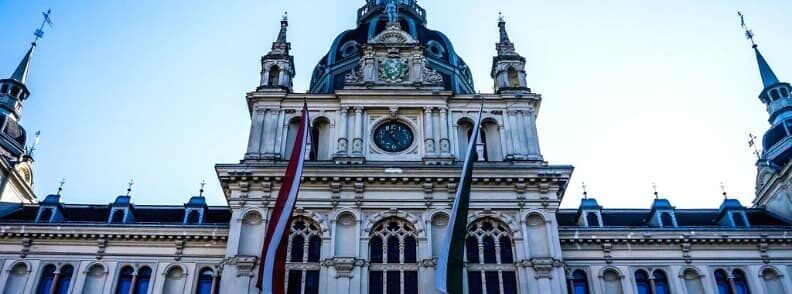
More Must-See Attractions in Graz
While you could easily fill a day with the classic sights of Graz, there are even more hidden gems and cultural highlights that are worth exploring. These spots may not be at the top of every tourist list, but they’re essential for anyone looking to dive deeper into what makes Graz truly special. Here are a few more attractions to round out your visit.
Grazer Dom (Graz Cathedral) and Mausoleum of Emperor Ferdinand II
No visit to Graz would be complete without a stop at the Graz Cathedral, a stunning late-Gothic church dating back to the 15th century. As you walk inside, you’ll be struck by the quiet beauty of the interior, but be sure to take a look at the outside as well. On the south facade, you’ll find the famous “plague painting,” which depicts three scourges: the plague, war, and locusts, a reminder of the city’s troubled past.
Just next door is the Mausoleum of Emperor Ferdinand II, one of the most significant examples of Mannerist architecture in Austria. The intricate design and the dome’s golden glow are truly a sight to behold. The Mausoleum houses the tombs of Ferdinand II and other Habsburg royalty, offering an up-close look at the grandeur of Austria’s imperial history.
Glockenspielplatz (Carillon Square)
For a delightful and slightly whimsical stop, head over to Glockenspielplatz. Every day at 11:00, 15:00, and 18:00, you’ll witness a charming performance of the Glockenspiel, where a pair of carved wooden figures in traditional Styrian dress dance to the melody of 24 bells. It’s a lovely moment that draws both locals and tourists alike, offering a sweet slice of Graz’s cultural heritage. The square itself is also a great spot to grab a drink or snack and soak in the atmosphere.
Gemaltes Haus (Painted House)
Just a few steps from Herrengasse, you’ll find the Gemaltes Haus, or Herzogshof (Decorated House). The entire facade of this building is covered in stunning baroque frescoes painted by Johann Mayer in 1742, depicting Roman gods and mythological scenes. The artwork is so detailed that it’s easy to miss some of the finer elements if you’re not looking closely. This beautiful building adds a layer of artistic charm to the city’s already colorful streets.
Palais Hotel Erzherzog Johann
Even if you’re not staying overnight, take a moment to visit the historic Palais Hotel Erzherzog Johann, located just off Sackstrasse. This hotel has been welcoming guests since 1852 and is one of the most elegant establishments in Graz. You don’t have to be a guest to enjoy the atmosphere — grab a drink in the lobby or dine in the hotel’s restaurant to get a taste of the old-world charm that makes this place special.
Schloss Eggenberg
For those who have a bit more time, Schloss Eggenberg, located on the western edge of Graz, is a must-see. This baroque palace, surrounded by beautiful gardens and a serene park, offers a glimpse into aristocratic life in the 17th century. Wander through its lavish rooms adorned with ceiling frescoes, visit the State Rooms, and explore the extensive art collection housed in the palace’s museum. The grounds are also home to a lovely peacock population, adding a bit of extra magic to your visit.
Karmeliterplatz and the Graz Museum
After descending from Schlossberg, head over to Karmeliterplatz and visit the Graz Museum, which offers an in-depth look at the city’s history and cultural development. It’s a quieter stop, perfect for those who want to dig deeper into Graz’s story, with exhibitions that cover everything from art to urban development.
Krebsenkeller (Crawfish Cellar)
If you’re a foodie, make sure to visit Krebsenkeller, a historic restaurant that’s been open since 1538. Nestled in a beautiful courtyard, it’s a great place to enjoy traditional Austrian fare. The courtyard is especially inviting in the summer when you can sit outside and enjoy a meal surrounded by history.
Graz Opera House
Even if you’re not catching a performance, a visit to the Graz Opera House is a must for architecture lovers. This stunning neo-baroque building dates back to the late 19th century, and its exterior alone is worth admiring. If you have the chance, consider booking a ticket to experience an opera or ballet in this magnificent venue.
As you explore more of these hidden corners of Graz, you’ll uncover the layers of history, art, and culture that make this city so unique. Graz is a place where every street tells a story, and every building holds a piece of Austria’s past. From grand cathedrals and vibrant squares to quiet museums and historic restaurants, these additional sights will enrich your experience and deepen your appreciation for this charming city.
Whether you’re marveling at the artwork on the Gemaltes Haus or sipping wine at Krebsenkeller, Graz has a way of making you feel like you’ve truly uncovered one of Austria’s hidden gems.
Best Day Trips from Graz
While Graz is brimming with things to see and do, one of the perks of visiting this city is how easy it is to escape into the surrounding Styrian countryside. If you’re looking to extend your adventure and experience more of what this region has to offer, some fantastic day trips from Graz allow you to explore beyond the city limits. Whether you’re into wine tasting or historical castles, these two trips will give you a taste of what makes Styria so special.
Escape to the Styrian Wine Road
If you’re craving a relaxing and scenic day trip, I can’t recommend the Styrian Wine Road enough. As someone who has spent countless weekends exploring the vineyards that stretch across this picturesque region, I can say that there’s nothing quite like sipping on local wine while overlooking the rolling hills. The Styrian Wine Road, or Steirische Weinstraße, offers an incredible opportunity to unwind after a busy day in the city.
Winding through charming villages and terraced vineyards, the road is dotted with small, family-run wineries that are the real gems of the region. What I love most is that many of these wineries are still relatively unknown to tourists, making them the perfect spots for an authentic, crowd-free experience. Weingut Tement is a personal favorite of mine, known for its award-winning Sauvignon Blanc, but I also encourage visitors to stop by Weingut Gross for a glass of their signature dry white wine.
And the best part? You don’t need to be a wine expert to enjoy this trip. Whether you’re a seasoned wine lover or just someone looking to soak in the breathtaking views, the Styrian Wine Road will leave you feeling refreshed and connected to the slower pace of life that characterizes this beautiful part of Austria.
Visit Riegersburg Castle on Shlossberg for a touch of adventure
If history and adventure are more your speed, then a visit to Riegersburg Castle is an absolute must. Perched dramatically on a volcanic hill, this imposing fortress is one of the most fascinating and well-preserved medieval castles in Austria. I remember my first visit there — standing at the foot of the castle and looking up, I felt like I had stepped back in time.
The hike up to the castle itself is part of the adventure, and I recommend walking up rather than taking the funicular if you want to fully appreciate the sweeping views of the countryside. Along the way, you’ll pass through centuries-old stone gates and fortifications that give you a sense of just how impenetrable this fortress once was. Inside, you’ll find a museum that showcases the castle’s long history, including exhibitions on medieval weaponry, witch trials, and the daily life of the castle’s former inhabitants.
One of my favorite fun facts about Riegersburg is that it was never taken by force — a testament to its strategic location and formidable defenses. As you explore the castle, you can almost feel the weight of its history pressing down on you, and it’s easy to imagine the lives of those who once lived and fought within its walls. It’s a perfect day trip for those who love a good blend of history, architecture, and a bit of adventure.
Both of these day trips offer something completely different yet equally memorable. Whether you’re sipping wine in a tranquil vineyard or exploring the halls of an ancient fortress, these escapes will add depth to your Graz visit and leave you with lasting memories.
Where to Stay in Graz: Hotel Erzherzog Johann Graz
When it comes to finding the perfect place to stay in Graz, you can’t go wrong with the Hotel Erzherzog Johann. Though I stay with family whenever I’m in the area, many of my friends and relatives have had the pleasure of staying at this charming hotel, and they always come back with glowing reviews. Nestled right in the heart of the old town, Hotel Erzherzog Johann Graz is the ideal choice for visitors who want to immerse themselves in the city’s rich history while enjoying all the modern comforts of a four-star hotel.
The Erzherzog Johann Hotel has been a part of Graz for over 150 years, and its classic elegance reflects the city’s unique blend of tradition and modernity. The hotel’s location is unbeatable, just steps away from key attractions like the Hauptplatz, the Schlossberg, and the Landeszeughaus. Whether you’re a first-time tourist eager to explore Graz’s top sights or a returning visitor ready to dive deeper into the city’s cultural offerings, this hotel places everything at your fingertips.
My cousin, who stayed at the Hotel Erzherzog Johann last summer, told me that the hospitality was impeccable. From the moment they arrived, the staff made sure their stay was comfortable and memorable. She particularly loved the room overlooking the vibrant streets below, and the décor — a blend of timeless charm and modern amenities — left a lasting impression. For those looking for something special, I’d recommend requesting one of their suites with a view of the Schlossberg; it’s a perfect way to wake up in the morning.
What also sets the Erzherzog Johann apart is its wonderful balance of luxury and homeliness. The rooms are cozy yet sophisticated, and the hotel offers a range of amenities, from a relaxing sauna to a rooftop terrace where you can enjoy a drink while gazing out at the city’s skyline. If you’re a foodie like me, you’ll love the on-site restaurant too — it’s renowned for its Styrian specialties, making it a great introduction to the local cuisine.
For anyone visiting Graz, especially if it’s your first time, Palais-Hotel Erzherzog Johann Graz offers a home away from home, where comfort meets culture in the best way possible. Whether you’re here for a short city break or an extended stay, this hotel is an excellent base for exploring all that Graz has to offer.
A Perfect Day in Graz: Fall in Love with Austria’s Hidden Gem
Every time I return to Graz, it feels like the city is welcoming me home. There’s something about this place that goes beyond its beautiful architecture and rich history — it’s the warm atmosphere, the blend of old and new, and the way it effortlessly captures both the heart and imagination. Whether you’re wandering through the narrow streets of the old town or standing atop the Schlossberg, soaking in the panoramic views, Graz has a way of leaving a lasting impression.
For me, the perfect day in Graz always starts at Schlossberg. There’s no better way to kick off your adventure than with a climb to the Uhrturm, the city’s iconic clock tower, where you’ll be rewarded with breathtaking views that stretch far beyond the rooftops of the old town. It’s a moment that never gets old, no matter how many times I’ve seen it. For a first-time visitor, it’s an unforgettable introduction to Graz — a view that will stay with you long after you’ve left the city.
From there, it’s all about exploring the city’s cultural treasures. The Landeszeughaus is a must for history lovers, with its fascinating collection of medieval weaponry. But even if history isn’t your thing, you’ll be captivated by the sense of stepping back in time as you wander through its halls. Graz’s charm lies in its ability to mix the past with the present. You can go from exploring the historic Erzherzog Johann Brunnen in the main square to marveling at the modern art installations in the Kunsthaus Graz, all within a few steps.
By midday, I always find myself drawn to one of the many cozy cafes scattered throughout the old town, where I can sip a coffee and people-watch for a while. It’s in these quiet moments that Graz’s charm shines through. The city feels alive, yet peaceful—an ideal spot to recharge before heading to your next adventure. If you’re like me, you’ll find it hard to leave without indulging in some of the local Styrian specialties at a traditional restaurant like Landhauskeller, where the flavors of the region are sure to win you over.
The truth is, Graz has a way of getting under your skin. No matter how many times I visit, I always find myself discovering something new — whether it’s a hidden alley with unique shops or a quaint little square I hadn’t noticed before. That’s why I keep coming back, and it’s why I believe anyone who visits for the first time will be hooked. One day in Graz is just enough to fall in love with this city, and I promise you’ll leave with memories that will have you planning your next visit before you’ve even left.
In the end, Graz isn’t just a city to visit; it’s a city to experience. It’s a place that welcomes you with open arms and leaves you with unforgettable moments. So, whether you’re a history buff, a foodie, or simply someone looking to soak in the beauty of a new destination, Graz is ready to enchant you. And trust me — it’s a place you’ll want to return to, time and time again.

Sarah Grossman, originally from Austria, has become a trusted voice in the travel community thanks to her deep knowledge of both European destinations and international travel. After completing her studies in Austria, she moved to Canada, where her passion for travel flourished. As an experienced traveler who has meticulously planned trips across the globe, Sarah is known for her expert advice and organizational skills, making her the go-to source for travelers seeking insightful, practical guidance. Her firsthand knowledge of Austria, especially Graz, sets her apart, as she combines local expertise with a global perspective that resonates with tourists and adventurers alike.
Sarah’s unique ability to weave her personal stories into her travel tips makes her content not only informative but also engaging and relatable. Her readers trust her to deliver authentic, detailed advice that can turn a simple trip into an unforgettable experience. With her roots in Austria, Sarah has a special connection to Graz and shares insider tips that only someone deeply familiar with the area can provide. Whether you’re planning a short visit or an extended stay, Sarah’s insights are invaluable for anyone looking to explore Graz like a local.
You too can become a guest blogger on The Travel Bunny. Just submit a free guest post.
Other travel articles you should read on The Travel Bunny blog
Beautiful late winter weekend in Vienna: 48 hours in Austria’s capital
Best things to do and places to visit in Vienna
Things to Do in Salzburg: 7 Best Activities for an Austrian Adventure

